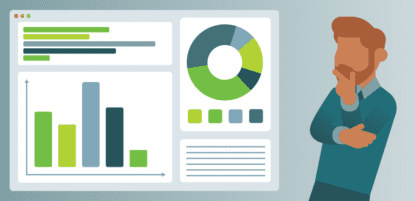ACH is getting a lot of buzz in recent news with same-day ACH transfers now sitting in Phase Three, the third and final phase of its two-year implementation process. While the implications of same-day ACH to accounts payable teams are exciting, this implementation means different things to businesses of different sizes.
For mid-market businesses, same-day ACH transfers can create a lot of opportunity for improvement within the accounts payable process. However, this improvement will likely come much more gradually than it does for larger corporations, depending on the selectivity of banks offering same-day ACH transfer services. But all this considered, it’s important to first understand the basics of B2B ACH transfers. Let’s take a closer look!
What is Business to Business ACH?
Business to Business ACH, also known as B2B ACH, is a type of electronic payment that enables businesses to transfer funds from one account to another for goods or services provided. This type of ePayment transfer is through the Automated Clearing House (ACH) network that safely connects all banks and financial institutions in the United States.
How Does B2B ACH Processing Work?
The process of B2B ACH processing is typically conducted within the following steps; payment is authorized, transaction is initiated, payment is requested, and payment is processed. The amount of time this process takes depends on what ACH speed you choose.
What Are the Different B2B ACH Processing Speeds?
Traditionally, business to business ACH payment can take three to five days to process, but there are different categories for the days it takes to process. Here’s a breakdown of the different options:
Standard: 4 to 5 business days
Expedited: 2 to 3 business days
Next Day ACH: 1 business day
Same Day ACH: End of business day
Some solutions, like MineralTree, offer easy-to-use same-day ACH payments that enable businesses to schedule payments based on each vendors’ preferred payment method. This allows AP teams to make more strategic decisions by giving them more control over DPO and cash flow.
What Are the Benefits of B2B ACH Transfers?
Here are some of the benefits that B2B ACH transfers provide to businesses:
Faster Payment Processing
One of the greatest benefits that same-day ACH transfers provide lies in their name: the money is transferred on the same day. This accelerates the settlement period that has historically been three days with traditional ACH transfers.
Faster payment processing is a boon for accounts payable teams, as they are able to benefit from increased command over short-term cash flow, and hang on to sums of money for longer amounts of time as it is beneficial to them.
Less Expensive
Compared to many alternative payment methods, especially paper checks and wire transfers, B2B ACH transfers are way more cost efficient, with a ACH transfer fee of less than $1 each.
Paper checks incur a lot of costs for businesses from the postage and time spent manually preparing and postmarking envelopes for payments. On average, the cost of paying with paper checks is estimated to be roughly $5 per check. In regards to ACH transfer vs wire transfers, banks charge between $10-$35 for domestic wire transfers, and international transfers cost even more. With businesses processing hundreds of payments each month, these costs add up.
Reduced Risk
ACH transfers still come with a level of risk, but it is far less than the level of risk assumed by businesses paying with paper checks of wire transfers. Paper checks were revealed as the top target for fraudsters in the AFP’s annual fraud survey, and the immediate availability of transferred funds makes wire transfer a risk as well.
In the wild, wild west that the world of B2B payments has become, a steady diet ACH transfers gives your business the best odds when it comes to fraud.
What Are the Challenges of B2B ACH Transfers?
There are still some challenges for businesses getting started with ACH payments. These are below.
Banks Vary in Terms of Their Payment Delivery Dates
While all of this sounds great, there is something important that you should know: Same-day ACH transfers are not ubiquitously offered to businesses by financial institutions.
In other words, banks and financial institutions verify businesses before offering both same-day ACH or traditional ACH transfers, and put businesses through a full underwriting process. This underwriting process is expensive and involves a lengthy application timeline. For this reason, banks are more focused on gaining large enterprises as customers that are processing higher volumes of payments to make this investment of time and money the most worthwhile. As a result, many mid-market businesses are struggling to get access to this valuable service.
ERPs Can Be Difficult to Manage
While ERPs are a beneficial tool, they are not designed with accounts payable in mind. ERPs are meant to serve the entire business, offering lots of opportunities for customization. However, this level of customization can be costly and time-consuming. Even with an accounts payable software, teams need to ensure a true bi-directionall sync, so that both platforms reflect the most up-to-date information.
Without an AP tool in place, out-of-the-box ERP tools face limitations. For example, even the businesses that have access to same-day ACH transfers have another factor that limits their ability to utilize it: a lack of support in their ERP.
Additional Payment Types Can Mean More Processes
With so many invoices to pay in a limited amount of time, accounts payable teams are less likely to step outside of the status quo to pay by ACH, and risk adding time to the process of queueing up a payment. That is, unless it is built into their payment process.
However, accounting software designed for mid-market businesses doesn’t usually build ACH transfers into the accounts payable process, and for that reason, paper checks are still the most commonly used payment method.
While most accounting software for large enterprises does build ACH into the AP process, this discrepancy represents another way that large enterprises have an edge over mid-market businesses when it comes to ACH transfers as a payment method.
How B2B Businesses Should Approach ACH Transfers
Businesses should understand that ACH transfers are one option in a stable of other good B2B payment options that are available at their behest.
In the same way ACH transfer has its benefits and limitations, so does every other payment option. However, by taking a strategic approach to how you are paying your vendors, you can ensure you are using the most appropriate payment method at the most appropriate time.
The best approach for mid-size businesses to take with ACH transfers is one that focuses on utilizing it in as many appropriate contexts as possible, while utilizing alternate payment methods where they are most appropriate. Some examples of contexts where ACH transfers are most appropriate include when vendors do not accept a corporate credit card or virtual card, and when immediate payment is not necessary.
Some alternate payment methods to consider when you are paying your vendors in contexts outside of the ones most appropriate for ACH transfers include:
Commercial Card
Credit card that businesses provide their employees paying directly from a corporate credit line for business related purchases. Excellent option for making instantaneous payments to vendors that accept this payment method, and earns you an average of 1% back on rebates.
Virtual Card
Virtual cards are an electronic payment method that uses a single-use, 16-digit number that issuers provide companies to pay for specific transactions. Excellent option for making instantaneous payments to vendors that accept this payment method, and also among the most secure payment options available today. This method also allows you to earn cash-back rebates.
Wire Transfer
Real-time payment method from one account to another. Among the riskiest payment options, as once payment is processed, funds are gone. This payment option should only be utilized when no other options are available.
Building an Vendor Payment Strategy Around ACH Transfers
Given the fact that the primary method for vendor payments today remains paper checks, the process of building a solid vendor payment strategy that includes the right balance of ACH transfers, commercial cards, and virtual cards is not going to happen overnight. However, there are steps you can take to immediately put yourself on track to getting there.
Step 1: Find Out Which of Your Vendors Accept Commercial Card Purchases
Whether or not you are already utilizing a commercial card for vendor payments, it never hurts to reassess which of your vendors are accepting payments via commercial card. Every payment that you make will result in cash back for you, so ignorance of applicable vendors can be costing you money.
Step 2: Start Shifting Spend to Electronic Payment Methods
As discussed earlier, not every mid-market company will be able to originate same-day ACH transfers right away. While it can take time to apply and receive the service from your bank, it doesn’t hurt to start paying electronically wherever you can. Trying to pay more with a digital commercial card or virtual card is a good place to start, and even utilizing traditional ACH transfer services as they are available to you is also a step in the right direction.
Step 3: Integrate your ERP with a Cloud-Based AP Automation Solution
With a long and arduous process required to process and pay invoices, juggling all of these different payment options can seem like a battle that is not worth the fight.
Integrating your ERP with a cloud-based accounts payable automation solution not only streamlines the lengthy process of paying invoices, but it also provides a centralized access point to all of your payment options, including ACH, commercial card, virtual card, and even paper check. With this setup, businesses that are still primarily using paper checks today can easily begin transitioning away while continuing to pay with them as necessary.
Mid-market businesses that integrate with these solutions are able to take a proactive approach to building a vendor payment strategy that optimizes their short-term cash flow, and gradually shifts their spend away from paper checks.
B2B ACH FAQs
What Information is Needed for a B2B ACH Transfer?
To make a B2B ACH transfer, businesses will need a bank account number, routing number, amount of the payment, and date of the payment.
What Are the Fees Associated with a B2B ACH Transfer?
The fees associated with B2B ACH transfers can vary depending on your bank or financial institution. That said, ACH transfers are typically cheaper than wire transfers.
Can B2B ACH Be Used for International Payments?
No, B2B ACH is primarily used for domestic transactions within the United States.





